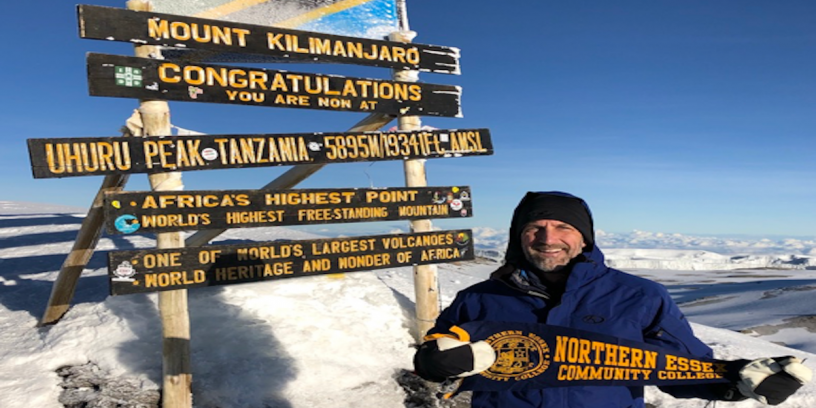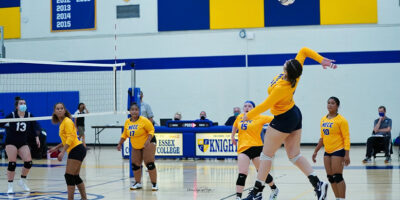This story is dedicated to the students of Northern Essex Community College, and to community college students everywhere.

NOTE: Three years ago today, on January 2, 2020, just before COVID-19 changed the world, I summited Mount Kilimanjaro and wrote this story of encouragement for community college students and their families, friends, and supporters. Since then, the global pandemic and its economic fallout have made an already challenging “climb” even harder for students. Still, in spite of the odds, they have shown a remarkable resiliency. Tomorrow begins winter intercession classes at NECC, followed by the spring semester in a few weeks. My hope is that all of our students are able to take these lessons—rely on their support team, Jambo!, and Polé, Polé—and make it to the top, knowing that all of us at NECC are here to support them.
I was a community college student, and now I am a community college president.
I have spent most of my career at community colleges and, although I recognize the challenges our students face, I continue to marvel at what they are able to overcome as they strive toward their goals.
I am also an adventure athlete who loves running, hiking, skiing, kayaking, obstacle course races, long distance relays—really anything that gets me outside and moving.
My hunger for adventure is what led me, my brother, and ten other hardy souls from around the world on a recent expedition to the summit of Mount Kilimanjaro in Tanzania, Africa.

At 19,341 feet high, with its spectacular volcanic craters, glaciers and ice fields, Mount Kilimanjaro is the highest mountain in Africa and the highest freestanding mountain in the world.
It took us five days of hiking, climbing, and camping to reach the top, and all along the way, I couldn’t help but recognize some important life lessons from the trek that community college students—and those who care for and support them—would do well to remember.
Rely on Your Support Team
Hikers on Mount Kilimanjaro are required to travel with local guides, and most also rely on a cadre of porters to help carry the equipment and provisions (tents, stove, fuel, water, food, and so on) necessary for a week on a mountain that begins in a hot, sweltering rainforest, winds upward through alpine deserts, and peaks among snowy glaciers.
At 52, I was the oldest member of our group by nearly twenty years. Still, I’m in pretty good shape, my (much) younger brother is a Cross Fit competitor, and the others included triathletes, ultramarathoners, and an Irish engineer from Malaysia who travels the world defusing World War II mines and unexploded bombs.
We were all dressed in merino wool base layers, wicking shirts, Gore-Tex coats and sturdy boots. We wore Garmin satellite watches, and our day packs were filled with CamelBaks, trekking poles, and energy bars.
On any other mountain, we’d be considered an experienced, formidable bunch.
On Kilimanjaro, we were bush leaguers.
The real heroes of the mountain that “rises like Olympus above the Serengeti” are the guides and porters.
Mostly young men from nearby towns and villages with limited access to electricity and running water, the porters of Kilimanjaro make twenty or more trips up the mountain each year, carrying 50-75 pounds of gear, dressed in secondhand sneakers and t-shirts.
Each morning, as we shouldered our packs and followed our guides back to the trail, the porters broke camp, strapped tents and kitchens to their backs, balanced enormous bags on their heads, and sped past us up the mountain; somehow getting it all set up again at the next camp by the time we arrived.

Hands down, Kilimanjaro porters are some of the best athletes in the world.
On top of their amazing physical abilities, the guides and many of the porters speak two or three languages, have extensive knowledge of the mountain’s climate, animal, and plant life; and are trained in high altitude first aid and emergency evacuation.
Without their strength, speed, knowledge and experience, most climbers—even strong, experienced ones—might never reach the summit.
The guides and porters on community college campuses are the faculty and support staff—advisors, tutors, librarians, financial aid counselors, and many more—who are available every day to help students trek through their classes and toward graduation.
They have knowledge and expertise that even the most prepared students will benefit from—if they take advantage of them.
Plenty of surveys and studies, like the Center for Community College Student Engagement’s A Matter of Degrees: Promising Practices for Community College Student Success, have shown that when students rely on advisors, tutors and professors to help them navigate the sometimes tricky terrain of college life, they, like climbers on Kilimanjaro, are more likely to make it to the top.
Jambo! (A Little Encouragement Goes a Long Way)
Although English is widely spoken in Tanzania, Swahili is the country’s official language, and it is one of the friendliest and most joyful languages you will ever hear.
There are dozens of ways to greet someone in Swahili, and while you may hear many of them while roaming the streets of Moshi or Arusha, every person you meet on the mountain is likely to wave a hand, flash a smile, and shout a cheerful, “Jambo!” (Hello), “Mambo!” (What’s up?), or “Poa, poa!” (Cool! Cool!)
The cheerfulness of these greetings is contagious—even in the hot, pouring forest rain at the base of the mountain—and by the time we made it to the first evening’s camp, we were all happily hello-ing each other, passing porters, and groups of fellow travelers.

For the final push to the summit, after hiking all day up the “Barranco Wall,” beneath the Helm Glacier, and across the Mweka Route, we ate dinner, rested in our tents for a few hours, and began to climb the last 4,500 feet at midnight, aiming to make Stella Point, just below the peak, and well above the clouds, at sunrise.

Everyone was tired, with many also suffering the effects of the thin air.
It was a test not just of physical stamina, but of mental willpower; and by 4 a.m., after nearly twenty hours of hiking at high altitude, the encouragement we received from our guides and each other made all the difference, and helped propel us to the top.
Community college students tend to be older; working while going to school, with little free time for socializing; and often the first in their families to attend college.
It can be a lonely path.
Orientation programs, First Year Experience classes, service learning projects, cohort-based certificate and degree programs, athletics, and clubs are some of the formal ways that community colleges try to “connect” students to campus.
Yet some of the most valuable relationships are built one-on-one, between students studying together, with a treasured professor from a student’s chosen career field, or an academic advisor who is always available with a reassuring, “Jambo! Poa, Poa!”
And for the family and friends of these hardworking scholars, hearing that you are there for them, proud of them, and eager for them to succeed—especially in late November and April, just before fall and spring finals—can make the difference between a student slumping down with her backpack and giving up on the trail; or climbing high above the clouds.
“Polé, Polé”
Altitude affects everyone differently. The higher you go; the more barometric pressure and oxygen levels drop. Some people may begin feeling the effects of these changes a mile (5,280 feet) above sea level, and anyone can struggle with a combination of headache, nausea, dizziness and fatigue above 8,000 feet.
The summit of Mount Kilimanjaro approaches 20,000 feet. At that height, there is about half as much oxygen as there is down below, and besides shortness of breath, vomiting, and delirium, some people are at risk of High Altitude Cerebral Edema, a build-up of fluid on the brain that can quickly lead to a coma or even death.
While being in good physical condition can certainly help you avoid or at least manage the worst of these symptoms, that’s no guarantee.
To help bodies not used to high elevation safely adjust, guides and porters on Kilimanjaro are constantly reminding climbers, “Polé, polé,” which is Swahili for “Slowly, slowly.” It’s not unusual, especially the higher you go, to take an hour or more to travel a single kilometer—a distance that may take only ten minutes around your block back home.
To help even more, climbers on Kilimanjaro will often hike up several thousand feet to experience thinner air, then descend again to camp further below. A few days and nights of this helps most people make it safely to the top.

Community college students may face similar challenges the “higher” they go, by taking more credits or upper level classes to complete their degrees.
But as they do, they frequently find themselves struggling to manage their time, balance competing commitments, and master new material.
When students fall behind or struggle with a class or a subject, it’s not a sign of weakness or some kind of character flaw. It means they are human, and like high altitude climbers, they are affected by the conditions all around them.
Besides the difficulty of the subject matter (Calculus and A & P can be real GPA wreckers and career changers), those conditions may also include a part-time job (or two), childcare, and maybe an unexpected transportation or healthcare challenge.
The stresses for working adults balancing life with the pursuit of an education can make climbing Kilimanjaro seem like a stroll in the park.
From time to time you may hear about the “low graduation rates” of community college students. Indeed, I would love to see more of our students—all of our students, really—graduate someday. But when you are balancing all those competing commitments, enrolling full-time and graduating on time can be a tall order.
So, two-thirds of our students are part-time, and many will attend classes for a semester or two, “stop out” for a bit, then return when they can. While they may not graduate in two years, they often do in five or six, or even eight or nine.
This form of academic “Polé, pole,” of “hiking up and camping down” may not be the quickest way to graduate; but it may be the way that eventually gets students up the steps of the commencement platform—the real summit of their climb—on graduation day.






